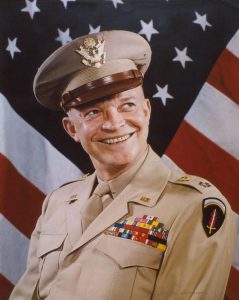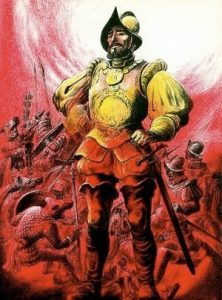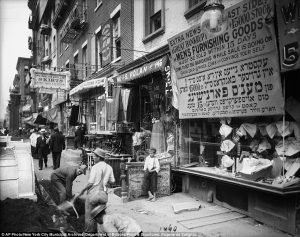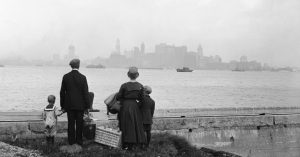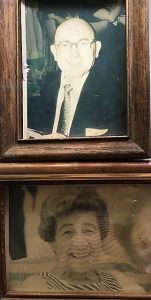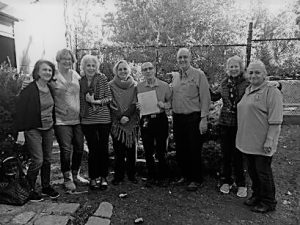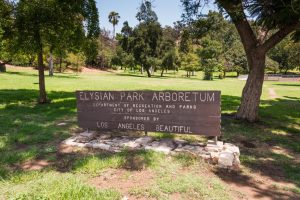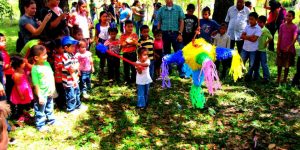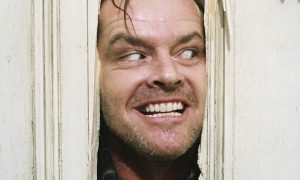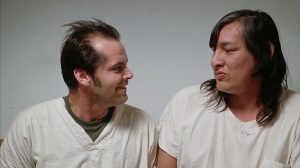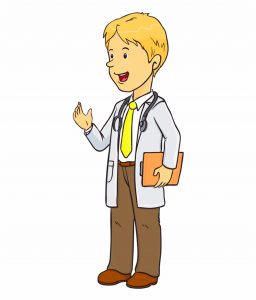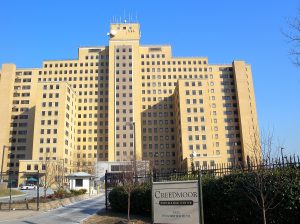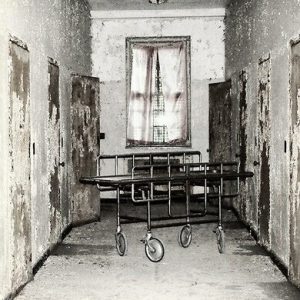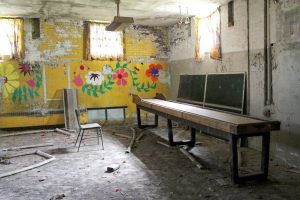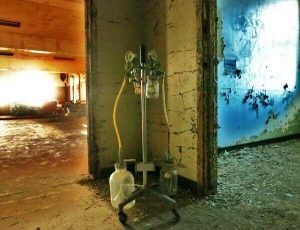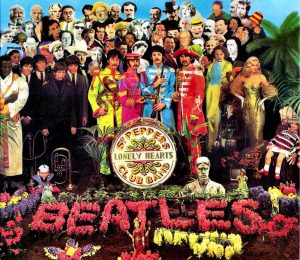Alley Pond Park, the Cousins’ Club, and the Loony Bin
I remember two things about Alley Pond Park from my early childhood in the 1950s. Neither was that it was the second biggest park in Queens County, one of the five boroughs of New York City, nestled at the far east borderline of Douglaston, Queens, just a stone’s throw from suburban Nassau County, where I grew up…. long before they built the east-west, Long Island Expressway right through the middle of Queens and Nassau.
No, what I do remember vividly, is that Alley Pond Park was the green-grassed, red picnic-tabled immigrant park of my forefathers, where my helter-skelter Russian Jewish family got together in their monthly summer, “cousins’ club” meetings. The second thing that I remember about the old park and those red picnic tables was that it was directly across the street, Winchester Boulevard, from Creedmoor Hospital, New York City’s 2nd most famous “nuthouse”, right in impressive line after Bellevue.
I grew up in Westbury, Long Island, directly across the street from Salisbury Park, soon to be re-named “Eisenhower Park”, after the famous World War II general who became America’s two-termed 34th President, during the buttoned down, conservative 1950s.
I used to chase errant golf balls hit over the chain link park fence by duffer weekend golfers, when I outran the pack of my neighborhood “Birchwood” friends to retrieve one of the hopefully still-pristine, Titleist or Wilson golf balls, to sell back to one of the grateful or irate duffers, for 50 cents or a dollar, depending on the condition of the ball. It was a good business for a kid. I also remember memorizing all the names of the cars of the day, along Salisbury Park Drive, for points towards my Cub Scout Wolf Pack badge: not only the Fords, Chevrolets, and Chryslers, but also old school cars like Hudson, LaSalle, and DeSoto, named after European colonial explorers, who I used to idolize, before history was “de-constructed” and the great “conquistadors” had their reputations tarnished and trashed.
But it was me and my sister, Alison, five years my junior, who felt like great adventurers, when we were packed into the Chevy Impala station wagon, perhaps twice a summer, and set out for Alley Pond Park with Mom and Dad on a Sunday afternoon, arriving an hour later at one of the other-worldly, or should I say, “old-worldly”, cousins’ club meetings. It was here, in Alley Pond Park, that the old world, East European Jews, from Russia, Poland, Lithuania, or perhaps Ukraine, who had migrated to New York, primarily right after the first World War, to places like Delancey Street in Lower Manhattan, and Bensonhurst, Coney island, Williamsburg, and East Rockaway in Brooklyn, came to meet in the 1950s, as they started to spread out from the densely-populated urban ghettos to the more-affordable suburban homes given to them under the post-war GI Act, even though many of the cousins still lived in Brooklyn and Queens, and were all hustling along varying rungs of the upwardly-mobile economic ladder.
Alley Pond Park was where Jewish-European immigrant families stayed together in the new country during the buttoned-down 50s, after having been crowded together into single tenement rooms in the Roaring Twenties on the Lower East Side of Manhattan. After they first congregated in cold water flats, having shuffled through U.S. immigration gates on Ellis Island, being forced to shorten their last names from “Truleransky” to “Trules”, from “Rosenfrokov” to “Ross”. When “your tired, your poor, your huddled masses yearning to breathe free”… rode past the Statue of Liberty in 1912, in 1917, in 1920, before, and after, America entered “The Great War”.
After which my housepainter paternal grandfather, Meyer, and his East Ukraine-born wife, Anna, brought up my father, “Yussel” (Joseph in English) and his younger sister, May, in an over-crowded, one-room apartment building in the poor Brownsville section of Brooklyn. After which my maternal grandmother, Sally, and grandfather, Murray, ran a corner grocery store in Middle Village, Queens for 40 years and brought out canned vegetables and fresh chicken to their kids and grandkids on Long Island every weekend they could.
And now, a generation later, it was here in Alley Pond Park, where stories of having barely-survived the Holocaust – were still kept alive – still fresh in Jewish memory, still fresh in the cousins’ psyches – some still seared into the numbers tatoo-ed onto their frail Semitic wrists. In this way, at least for me, the cousins’ club was both a way to keep alive a shameful family history, and simultaneously, a way to watch the dream of a new life take root in a new land and come to fruition.
I didn’t know any of the economics, history, or sociology at the time; I only came to recognize sad-looking Uncle Miltie, with his blue and yellow checkered Bermuda shorts and his horn-rimmed tortoise-shell glasses, who was always “down on his luck”, and old Aunt Sadie, with her thick, rolled-stocking ankles and her heavy black shoes, ever sporting a hard-to-look-at black bristle on her lower chin and who talked with a thick, inpenetrable Yiddish accent. In fact, most of the cousins seemed to talk this strange half-German, old-world language to each other, including my parents, who usually only used Yiddish at home when they didn’t want me and my sister to understand some private code between them.
“Kinder un gelt is a shaine velt.” (“Children and money make a nice world.”)
Somehow, I seemed to forget this old world Yiddish expression for my first fifty years, never marrying until I was 56, not becoming a father until I was 68, and still, never owning a house!
Yet as I said, I still vividly remember the green, green grass and the redwood picnic tables in Alley Pond Park, which surprisingly, remind me of the modern-day concrete and artificial wood picnic tables amidst the green, green grass in Elysian Park, two blocks from my house in the hills of Echo Park, right near Dodger Stadium, where an entirely different generation of immigrant families, speaking Spanish, not Yiddish, gather every weekend admidst the dancing mariachi music, the delicious smell of barbecue, and the happy children swinging baseball bats at hanging birthday pinatas.
It’s a lovely connection, keeping Alley Pond Park alive for me, sixty-five years past my childhood, when I now find myself raising my own, adopted immigrant boy, albeit without any trace of his extended Indonesian family, who didn’t make the heroic “Coming to America” journey, along with Eddie Murphy, my Russian Jewish 1950s cousins, or the 21st century Latino immigrants from El Salvador, Mexico, and Guatemala, all meeting Sundays in the green, green grass of Elysian Park, coincidentally the second biggest park in the 21st century City of Angels.
Which brings me back across the street… to Creedmoor.
Of course, back in the 1950s, it was just the big imposing, burly brick building across the street, beyond the lake, from the cousins’ club meetings. I didn’t know the street was called Winchester Boulevard. Why would I? How would I know that Creedmoor would one day loom large in my life? Far larger than it did in the 50s, when as an still under-10-year old, I only knew that it was the famous “loony bin” or “nut house”, as I said, we called it in those days, long before Ken Kesey’s and Hollywood’s “One Flew Over the Cuckoo’s Nest” brought names and words like Randall McMurphy, Nurse Ratched, “lobotomy”, and “sociopath” to widespread public awareness.
Still, mental illness was a scary thing back in the 1950s and 1960s. I remember my Aunt May had to undergo a couple of rounds of “electro-shock therapy”, which is what McMurphy got before he got his terminal lobotomy, and hearing that my aunt had to be taken away for this kind of “shocking” treatment was just – way past the realm of “normal” in my family, particularly before things started to get “far out” and “counter-cultural” a few years later.
Nevertheless, as the son of a nice middle-class, suburban Jewish-American family, it was not surprising that I was more or less expected to become “my son, the doctah”. The same with all my nice middle-class, suburban, Jewish-American friends. Hell, what did we know? It was just the next step along the American immigrant conveyor belt of upwardly-mobile education and achievement. Our grandparents were blue-collar house painters and grocery store clerks, our parents were white-collar businessmen and garment industry deal-makers, and we were going to become professionals: doctors, lawyers, and Indian Chiefs.
That meant: going to school, getting good grades, taking SAT tests, multiple times, getting into the best colleges we could, graduating, taking the MCATs or LCATs to get into law school (if you couldn’t get into med school) – all of which made us – set for life. No questions asked.
So by the summer of 1967, I was well along into my pre-med program at UB (the University of Buffalo, soon to be renamed “State University of New York at Buffalo”, the best of the state universities). I had taken my hateful inorganic chemistry course, dropped calculus and physics twice each, and managed to get a B in organic chemistry, only because I had a brilliant professor who made the dry, mysterious chemistry equations into beautiful poetry. The program was pure drudgery, but I figured out quickly that that was the way they separated the wheat from the chaff, the persevering and dedicated doctors-to-be from the slackers and lazy students who would soon switch majors to social psychology or English literature.
It was between my sophomore and junior years that I was diligently looking for a summer job. I had already naively “decided” on my doctoral specialty – psychiatry – so I was both aggressive and lucky – to get a summer internship at – you guessed it – Creedmoor Psychiatric Hospital, on Winchester Boulevard in Queens.
The internship was on – the children’s autistic ward. And it wasn’t pretty.
By this time, 1967, Creedmoor Hospital was in great disrepair as a state mental institution. It was over-crowded and under-staffed. To say that the walls were in need of paint was like saying the patients were in need of better care. Both were embarrassing understatements.
Why they hired me was also a mystery. It was not like I had any experience whatsoever on a ward. But that was exactly where I was placed. A privileged, still-wet-behind-the-ears, 20-year old college kid – thrown onto a ward – full of severely disturbed, early adolescent teenagers who were abandoned by their parents and society, forcibly adopted by the State of New York into crumbling and terrifying prison-like facilities, and then treated like medicated animals. I entered the ward each morning with a long-toothed skeleton key dangling from my waist.
“Mr. Troof. Mr. Troof. Basket play. Basket play.”
That was Stanley, a seventeen-year old, wiry black autistic teenager on the ward. It was still years before the term “African American” became politically correctly, but years after “Negro” was pushed to the dust pile of history. Stanley was the oldest “child” on the ward at seventeen; the next year he would be transferred to an adult ward, probably for the rest of his life. I didn’t know how long Stanley had been on the ward, nor did I know how long the younger kids had been there either, but as I said, these severely damaged and withdrawn kids had either been deposited at Creedmoor by their parents directly, a very few of whom still visited their abandoned children on very rare occasion, or more likely, they had been transferred by Social Services, as a last resort, the state having no other place to “store” them.
All of the kids were put on heavy doses of Thorazine (an anti-psychotic drug that “slowed them down”), and they were kept locked up in dayrooms for the entire day. They were fed in lunchrooms where they wouldn’t sit down, but instead ran around the food tables like herds of wild animals, stuffing food into their mouths as fast as they could, thinking they had to compete for the food supply. At the end of the day, they were locked into their “cells” for the night, with even stronger dosages of meds, hours after I had already gone home for the day.
Stanley was the brightest and most cheery of the bunch. There was Larry, an emaciated, near-bald, voiceless thirteen year old, who looked like a child Auschwitz victim who tore up his prison-like uniform into rag-like strips, with which he tied up his arms, so as to not to beat himself as severely as he would have if his arms weren’t tied. Yet no amount of medicine could stop Larry from beating himself. There was Kevin, another black, fourteen-year-old autistic teenager, whose mother still occasionally came to visit him, who, as stocky as Stanley was rail thin, banged his head against the concrete wall, also no matter what dosage of Thorazine he was given. Most of the kids were mute, one of the most prevalent and uncurable signs of childhood autism, and although they had social workers who very occasionally came to work with them one on one, this childhood Creedmoor ward was part of a hopeless, lock-down state institution of great despair and hopelessness.
It made me extremely depressed. In the first few weeks of working there, I’d bring in any toys I could find for the kids to play with and I’d leave them in the dayroom. Within the first fifteen minutes, the toys would be completely destroyed. Even a basketball would be punctured and completely flattened. I had no idea how these poor desperate kids did it.
“Mr. Troof. Mr. Troof. Basket play. Basket play.”
I offer wonder what happen to all these kids. They still haunt me in my dreams.
I’d drive home after work from Creedmoor, from Douglaston to Westbury, where I struck up a hopeful summer relationship with Enid, the girl who I wasn’t brave enough to have a relationship with in high school. I remember parking my big brown Pontiac Bonneville out in front of her house on Gloucester Driver, listening to the Box Tops singing “The Letter”:
“Gimme a ticket for an aeroplane Ain’t got time to take a fast train”…
Maybe that’s what I wanted. A ticket out of the loony bin. Out of the doldrums and depression of working with these poor mute, autistic kids… as a helpless, hopeless… orderly.
Enid helped me. She “turned me on” for the first time – to marijuana. I remember listening to the Beatles “A Day in the Life” on “Sergeant Pepper’s Lonely Hearts Club Band” and thinking I was having a heart attack – just at the height of the towering musical crescendo.
My life changed that summer, after Creedmoor.
I no longer wanted to become a psychiatrist. I was scared off. Depressed off. I changed my major the next fall semester… probably to social psychology… or English literature. I didn’t go to my college graduation. I became an artist, a member of the counter-culture.
————
I look back to Alley Pond Park. To my Jewish-American ancestors and their cousins’ club. I remember the loony bin across the street, Creedmoor Hospital…
…to the place that made all the difference.
Travel the world with “e-travels with e. trules” blog
Become a Subscriber of his Santa Fe Substack.
Listen to his travel PODCAST
Or go to his HOMEPAGE

